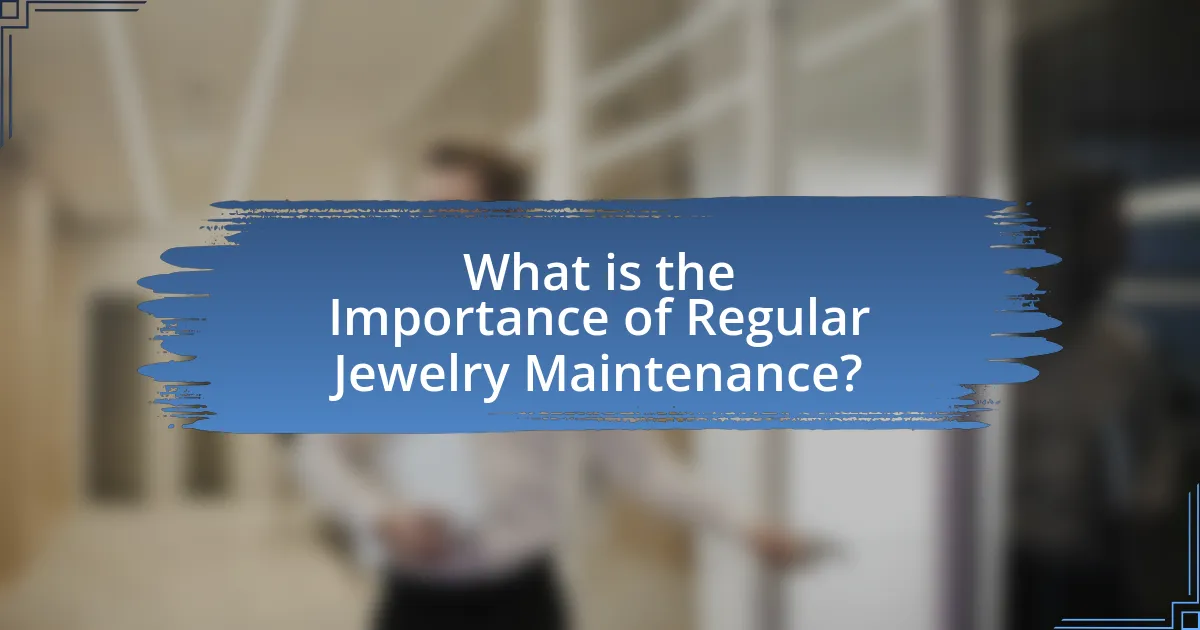Regular jewelry maintenance is essential for preserving the integrity, appearance, and value of jewelry pieces. This article outlines the importance of routine activities such as cleaning, inspecting for damage, and ensuring secure settings to prevent deterioration and extend the lifespan of jewelry. It discusses the types of damage that can occur without maintenance, the impact on jewelry value, and the key components of a maintenance routine, including recommended cleaning methods and inspection frequency. Additionally, it addresses common misconceptions about jewelry care and provides practical tips for effective maintenance, emphasizing the financial and aesthetic benefits of regular upkeep.

What is the Importance of Regular Jewelry Maintenance?
Regular jewelry maintenance is crucial for preserving the integrity, appearance, and value of jewelry pieces. Maintenance activities, such as cleaning, inspecting for damage, and ensuring secure settings, prevent deterioration and prolong the lifespan of the jewelry. For instance, regular cleaning removes dirt and oils that can cause tarnishing or corrosion, while inspections can identify loose stones or weakened clasps before they lead to loss or damage. According to the Jewelers of America, routine maintenance can enhance the longevity of jewelry by up to 50%, underscoring its importance in maintaining both aesthetic and monetary value.
Why is regular maintenance essential for jewelry longevity?
Regular maintenance is essential for jewelry longevity because it prevents damage and preserves the integrity of the materials. Jewelry is often exposed to environmental factors, such as moisture, chemicals, and physical wear, which can lead to tarnishing, scratching, or loosening of stones. For instance, routine cleaning can remove dirt and oils that accumulate over time, while inspections can identify potential issues like loose settings before they result in loss or damage. Studies show that properly maintained jewelry can last significantly longer, with some pieces enduring for generations when cared for correctly.
What types of damage can occur without regular maintenance?
Without regular maintenance, jewelry can suffer from various types of damage, including tarnishing, stone loosening, and metal fatigue. Tarnishing occurs when metals react with moisture and air, leading to discoloration and loss of luster. Stone loosening can happen due to wear and tear, increasing the risk of losing precious stones. Metal fatigue results from constant stress and can lead to cracks or breaks in the jewelry. Regular maintenance, such as cleaning and inspections, can prevent these issues and extend the lifespan of jewelry.
How does maintenance affect the value of jewelry?
Maintenance significantly affects the value of jewelry by preserving its condition and enhancing its aesthetic appeal. Regular cleaning, inspection, and repairs prevent damage such as scratches, loose stones, or tarnishing, which can diminish the jewelry’s market value. For instance, a study by the Gemological Institute of America indicates that well-maintained jewelry can retain up to 80% of its original value, while neglected pieces may lose significant worth due to deterioration. Therefore, consistent maintenance not only sustains the jewelry’s physical integrity but also ensures its financial value remains high.
What are the key components of jewelry maintenance?
The key components of jewelry maintenance include regular cleaning, proper storage, and periodic professional inspections. Regular cleaning removes dirt and oils that can dull the appearance of jewelry, while proper storage prevents scratches and tangling. Periodic professional inspections help identify any potential issues, such as loose stones or damaged settings, ensuring the longevity of the piece. These practices are essential for preserving the aesthetic and structural integrity of jewelry over time.
What cleaning methods are recommended for different types of jewelry?
For cleaning different types of jewelry, specific methods are recommended based on the material. For gold jewelry, a mixture of warm water and mild dish soap is effective; gently scrub with a soft brush, then rinse and dry. Silver jewelry benefits from a silver polishing cloth or a solution of baking soda and water, applied with a soft cloth, followed by rinsing and drying. For diamond jewelry, a solution of warm water and dish soap is suitable; use a soft brush to clean, then rinse thoroughly. Pearls require a gentle approach, using a damp cloth to wipe them down after wear, avoiding immersion in water. Finally, costume jewelry should be cleaned with a soft, dry cloth to avoid damage to any coatings or glues. These methods are validated by jewelers who emphasize the importance of using gentle cleaning agents to maintain the integrity of the jewelry.
How often should jewelry be inspected for wear and tear?
Jewelry should be inspected for wear and tear at least twice a year. Regular inspections help identify issues such as loose stones, worn prongs, or damaged clasps before they lead to more significant problems. According to the Jewelers of America, routine maintenance can extend the life of jewelry and ensure its safety and appearance.
What common misconceptions exist about jewelry maintenance?
Common misconceptions about jewelry maintenance include the belief that all jewelry can be cleaned with the same methods and that professional cleaning is unnecessary. Many people assume that household cleaners are safe for all types of jewelry, but this can damage delicate materials like pearls and opals. Additionally, some individuals think that jewelry does not require regular maintenance if it appears clean, overlooking the fact that dirt and oils can accumulate over time, leading to tarnishing or weakening of settings. Regular professional cleaning and maintenance are essential for preserving the integrity and appearance of fine jewelry, as recommended by jewelers and industry experts.
Why do some people believe that jewelry doesn’t need maintenance?
Some people believe that jewelry doesn’t need maintenance because they perceive it as a durable and timeless accessory that can withstand daily wear without degradation. This belief is often reinforced by the materials used in jewelry, such as gold and platinum, which are resistant to tarnishing and corrosion. Additionally, many individuals may not be aware of the potential for damage from factors like exposure to chemicals, physical impacts, or improper storage, leading them to underestimate the need for regular care.
How can misinformation lead to costly repairs?
Misinformation can lead to costly repairs by causing individuals to neglect proper jewelry maintenance or to use incorrect cleaning methods. For example, believing that all jewelry can be cleaned with the same solution may result in damage to delicate materials, necessitating expensive repairs. A study by the Jewelers of America found that improper care can reduce the lifespan of jewelry, leading to increased repair costs over time.
How can regular maintenance enhance the appearance of jewelry?
Regular maintenance enhances the appearance of jewelry by preventing tarnish, scratches, and dirt buildup. Cleaning jewelry regularly removes contaminants that dull its shine, while professional inspections can identify and address issues like loose stones or damaged settings, ensuring the jewelry remains visually appealing and structurally sound. For example, a study by the Gemological Institute of America highlights that routine cleaning can restore the brilliance of diamonds and other gemstones, significantly improving their aesthetic value.
What cleaning products are safe for various materials?
For cleaning jewelry made from various materials, safe products include mild soap and water for gold and silver, a mixture of vinegar and baking soda for tarnished metals, and specialized jewelry cleaners for gemstones. These products are effective because they do not contain harsh chemicals that can damage the materials. For instance, using a soft cloth with soapy water is recommended for pearls to avoid scratching their surface. Additionally, ammonia-based cleaners should be avoided on porous stones like opals and turquoise, as they can cause damage.
How does polishing improve the shine and luster of jewelry?
Polishing enhances the shine and luster of jewelry by removing surface scratches and oxidation, which dull the appearance of the metal or gemstones. The process involves using abrasive materials or compounds that smooth the surface, allowing light to reflect more effectively. For instance, polishing gold jewelry can restore its original brightness, as studies show that polished surfaces can reflect up to 90% of light compared to unpolished surfaces, which may reflect significantly less. This restoration of surface smoothness is crucial for maintaining the aesthetic appeal of jewelry, making it look new and vibrant.
What are the risks of neglecting jewelry maintenance?
Neglecting jewelry maintenance can lead to significant risks, including damage, loss of value, and potential health hazards. Over time, dirt and oils can accumulate on jewelry, causing tarnishing and weakening the metal, which may result in breakage. For instance, a study by the Gemological Institute of America highlights that regular cleaning can prevent the deterioration of gemstones and metals, preserving their luster and structural integrity. Additionally, loose stones can fall out if not properly maintained, leading to financial loss and emotional distress. Furthermore, neglected jewelry can harbor bacteria, posing health risks when worn. Regular maintenance is essential to mitigate these risks and ensure the longevity and safety of jewelry.
How can neglect lead to irreversible damage?
Neglect can lead to irreversible damage in jewelry by allowing dirt, moisture, and corrosion to accumulate, which can weaken the structural integrity of the pieces. For example, neglecting to clean a gold ring can result in tarnishing and pitting, making it impossible to restore its original luster. Additionally, gemstones can become loose or fall out if settings are not regularly checked, leading to permanent loss. Studies show that regular maintenance can extend the lifespan of jewelry significantly, while neglect can lead to costly repairs or total loss, emphasizing the critical need for consistent care.
What are the potential costs associated with repairs due to neglect?
Neglecting regular jewelry maintenance can lead to significant repair costs, often ranging from 10% to 50% of the original purchase price of the jewelry. For instance, a ring that originally costs $1,000 may incur repair costs between $100 and $500 if issues like loose stones or tarnishing are not addressed promptly. Additionally, neglect can result in complete loss of gemstones or structural integrity, leading to replacement costs that can exceed the original value. According to a study by the Jewelers of America, regular maintenance can prevent up to 80% of potential repair costs, highlighting the financial benefits of proactive care.
How can one establish a regular jewelry maintenance routine?
To establish a regular jewelry maintenance routine, one should schedule periodic inspections and cleanings of their jewelry pieces. This involves checking for loose stones, signs of wear, and tarnishing, which can be done every six months. Regular cleaning can be performed using a mild soap solution and a soft brush, ensuring that the jewelry remains in good condition. Additionally, storing jewelry properly in a dry, separate space can prevent scratches and tangling. Following these steps helps maintain the integrity and appearance of the jewelry over time.
What steps should be included in a jewelry care routine?
A jewelry care routine should include cleaning, proper storage, regular inspections, and professional maintenance. Cleaning involves using a soft cloth or a gentle jewelry cleaner to remove dirt and oils, which helps maintain the shine and integrity of the pieces. Proper storage requires keeping jewelry in a dry, cool place, ideally in a lined box or pouch to prevent scratches and tangling. Regular inspections should be conducted to check for loose stones or signs of wear, ensuring any issues are addressed promptly. Professional maintenance, such as periodic polishing and repairs, is essential for preserving the quality and longevity of fine jewelry. These steps collectively help prevent damage and keep jewelry looking its best.
How can professional services complement personal maintenance efforts?
Professional services can enhance personal maintenance efforts by providing specialized expertise and tools that ensure jewelry is maintained to the highest standards. For instance, professional jewelers possess advanced cleaning techniques and equipment that can remove tarnish and restore shine more effectively than typical home methods. Additionally, they can identify and address potential issues, such as loose stones or weakened settings, that may not be apparent to the untrained eye. Research indicates that regular professional maintenance can extend the lifespan of jewelry significantly, with some studies showing that items maintained by professionals can last up to 50% longer than those only cared for at home.
What practical tips can help maintain jewelry effectively?
To maintain jewelry effectively, regularly clean it using a soft cloth and mild soap solution. This practice removes dirt and oils that can dull the appearance of the jewelry. Additionally, store jewelry in a dry, cool place, preferably in a fabric-lined box or pouch to prevent scratches and tangling. Avoid exposing jewelry to harsh chemicals, such as those found in household cleaners, as they can damage the metal and stones. Lastly, schedule professional inspections and cleanings at least once a year to ensure that settings are secure and to address any wear and tear. These tips are supported by industry standards that emphasize the importance of regular maintenance for preserving the integrity and beauty of jewelry.
How can proper storage prevent damage to jewelry?
Proper storage prevents damage to jewelry by minimizing exposure to environmental factors and physical abrasion. Storing jewelry in a cool, dry place reduces the risk of tarnishing and corrosion caused by humidity and temperature fluctuations. Additionally, using individual compartments or soft pouches prevents pieces from scratching each other, which is crucial for maintaining their appearance and integrity. Research indicates that jewelry stored in protective cases experiences significantly less wear and tear compared to items left in open or cluttered spaces.
What are the best practices for wearing jewelry to minimize wear?
To minimize wear on jewelry, individuals should remove pieces during activities that may cause damage, such as exercising, swimming, or cleaning. This practice prevents exposure to harsh chemicals and physical impacts that can scratch or tarnish the jewelry. Additionally, storing jewelry in a soft-lined box or pouch when not in use protects it from scratches and tangling. Regular cleaning with appropriate solutions, such as mild soap and water for most metals, helps maintain the jewelry’s appearance and integrity. Research indicates that proper care can extend the lifespan of jewelry significantly, with some studies showing that regular maintenance can reduce wear by up to 50%.


